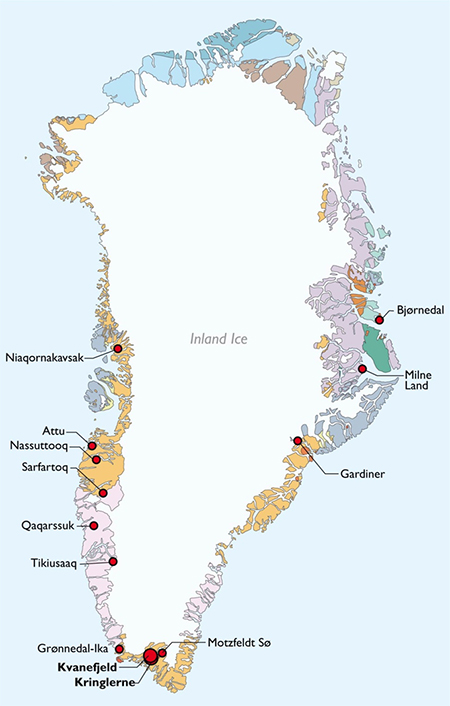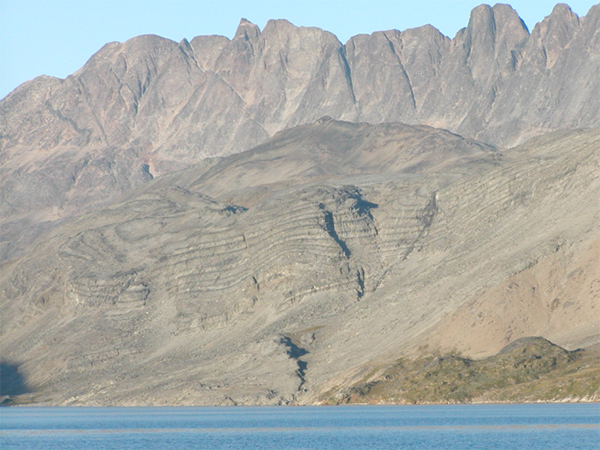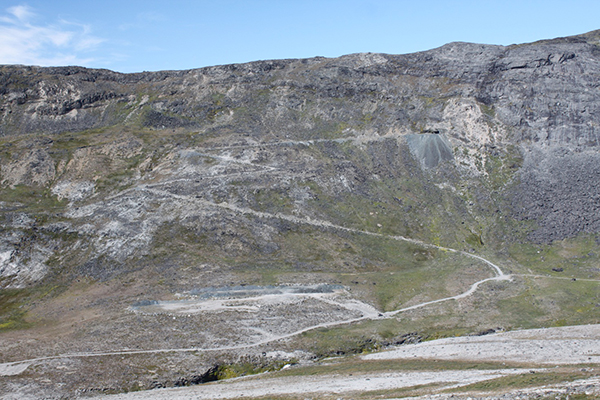REE mineralisation in Greenland
Greenland is endowed with several large REE deposits in various geological settings. The largest deposits by far are hosted in peralkaline intrusions related to the Gardar Province in south Greenland, encompassing the deposits around Kvanefjeld, Kringlerne, and Motzfeldt Sø. Additionally, four carbonatite-related REE deposits are known from the west coast, and one alkaline intrusion (Kap Simpson) and one palaeoplacer deposit (Milne Land) are located in east Greenland. The first scientific descriptions of REE minerals in Greenland were carried out by K L Giesecke in 1806, who described the minerals arfvedsonite, eudialyte and sodalite in the Ilímaussaq complex.
Geology of Greenland
Southern west Greenland and southern east Greenland are part of the North Atlantic craton and mainly consist of high-grade Archaean orthogneisses with smaller units of intrusive and supracrustal rocks. Parts of the rocks in the craton were reworked during Palaeoproterozoic orogenic events. The Mesoproterozoic Gardar province in south Greenland is an intracratonic rift province including sandstones and a variety of volcanic and plutonic igneous rocks of alkaline and peralkaline affinity. Greenland is also endowed with a number of carbonatite associated REE deposits, most notably the Sarfartôq carbonatite complex, Qaqarssuk carbonatite and Tikiusaaq carbonatite, which all intruded into the orthogneisses of the North Atlantic craton.
REE mineralisation
Of the intrusions in the Gardar province, the economically most important for REE are the Ilímaussaq intrusion (1160 Ma), hosting the Kvanefjeld and Kringlerne REE deposits, and the Igaliko nepheline syenite complex (1273 Ma), hosting the Motzfeldt Sø REE deposit.
The Ilímaussaq intrusion was largely emplaced during block subsidence and formed by three pulses, of which the third formed layered series of nepheline syenites enriched in REE as well as uranium (U), thorium (Th), niobium (Nb), tantalum (Ta), beryllium (Be), zirconium (Zr) and fluorine (F). The Ilímaussaq intrusion hosts two world class REE deposits:
- Kvanefjeld: an intermediate series sandwiched between roof and floor series, consisting mainly of lujavrites, in which the main REE mineral is steenstrupine
- Kringlerne: comprising 29 exposed cyclic layers of kakortokite making up the bottom cumulates of the intrusion; the main REE mineral is eudialyte
The Motzfeldt Sø REE deposit is part of the Motzfeldt centre, which in turn is one intrusion of the Igaliko nepheline syenite complex, and shows significant Ta-Nb enriched zones in altered syenite and minor pegmatite and diorite dykes, and high grade REE intersections that are related to the pegmatite intrusives at depth.
The Greenlandic REE-enriched carbonatites vary in age between the Archaean and Jurassic. The most important of those, in terms of REE resources, are Sarfartôq, Qaqarssuk and Tikiussaq.
The Sarfartôq carbonatite intrusion is located on a Precambrian thrust zone and intruded about 600 Ma during the opening of the Iapetus Ocean. The core of the complex consists of rauhaugite with schlieren of sövite and beforsite dykes, surrounded by a sodium-type fenite zone with pyrochlore-bearing rocks. The carbonatite contains REE bearing minerals in veinlets of dolomite and REE-carbonatite, and in shear zones.
The Qaqarssuk (or Qeqertaasaq) phoscorite-carbonatite complex consists of carbonatite ring dykes that intruded into the Archaean basement at 173 Ma. The carbonatite is surrounded by fenitised basement. The ring dykes consist of sövite, olivine-sövite, and dolomite carbonatite. They are cut by late-stage sövite veins, REE-carbonatite veins, ferrocarbonatite and lamprophyre dykes.
The carbonatite complex Tikiusaaq was discovered in 2005, on the basis of a study of regional stream sediment geochemistry and aeromagnetic data. The complex consists of a central intrusive carbonatite surrounded by a fenite zone with carbonatite and aillikite dykes.
The Niaqornakavsak and Umiamako Nuna are two small high-grade REE occurrences in the Palaeoproterozoic Karrat Group in central west Greenland. The Karrat Group consists of metasediments and metavolcanic rocks and the REE-enriched horizons consist of banded carbonates in amphibolites.
In east Greenland the Jurassic placer deposit on Milne Land forms another potential source for REE. The deposit lies within Mesozoic basins that formed during the opening of the North Atlantic Ocean. The placer consists of heavy mineral-rich arkosic sandstones and breccias rich in zircon, monazite and titanium minerals, of which monazite is the main REE mineral.
East Greenland hosts a range of Palaeogene syenitic and nepheline-bearing intrusions that were formed during the opening of the Atlantic Ocean. The most important of these, in terms of REE mineralisation, is the Gardiner complex. In this complex, the most important REE-bearing phases are perovskite, titanite and apatite.
Key references
The following list comprises a non-exhaustive list of papers and books on the geology of Greenland and the REE occurrences on Greenland.
Henriksen, N, Higgins, A K, Kalsbeek, F, and Pulvertaft, C R. 2009. Greenland from Archaean to Quarternary. Descriptive text to the 1995 Geological map of Greenland, 1:2 500 000. 2nd edition.
Knudsen, C. 1991 Petrology, geochemistry and economic geology of the Qaqarssuk carbonatite complex, southern West Greenland. Monograph Series on Mineral Deposits 29, 110 pp.
Larsen, L M, Rex, D C, and Secher, K. 1983. The age of carbonatites, kimberlites and lamprophyres from southern West Greenland: recurrent alkaline magmatism during 2500 million years. Lithos. 16: 2 15–221.
Larsen, M, Piasecki, S, and Surlyk, F. 2003. Stratigraphy and sedimentology of a basement-onlapping shallow marine sandstone succession, the Charcot Bugt Formation, Middle-Upper Jurassic, East Greenland. Geological Survey of Denmark and Greenland Bulletin 1, 893–930.
Nielsen, T F D. 1987. Tertiary alkaline magmatism in East Greenland: a review. Geological Society, London, Special Publications 30, 489–515.
Schatzlmaier, P, Schöllnberger, W, and Thomassen, B. 1972. Untersuchung des Vorkommens an Zirkon und seltenen Erden auf Kote 800 Milneland. Internal report, Nordisk Mineselskab A/S, 91 pp GEUSDodex # 20669.
Secher, K and Larsen, L M. 1980. Geology and mineralogy of the Sarfartôq carbonatite complex, southern West Greenland. Lithos 13, 199–212.
Sørensen, H. (ed.) 2001. The Ilímaussaq alkaline complex, South Greenland: status of mineralogical research with new results. Geology of Greenland Survey Bulletin 190. 167 pp.
Sørensen, L L and Kalvig, P. 2011. Geology and Ore. 20/ 2011. GEUS; 12 pp.
Tappe, S, Steenfelt, A, Heaman, L M, and Simonetti, A. 2009. The newly discovered Jurassic Tikiusaaq carbonatite-aillikite occurrence, West Greenland, and some remarks on carbonatite-kimberlite relationships. Lithos 112, 385–399.



